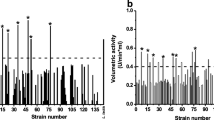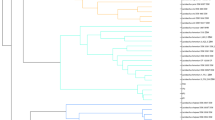Abstract
A high variety of plants that are used for food production contain esterified hydroxycinnamic acids. As their free forms display several benefits, like an enhanced absorption in human intestinal tract, anti-oxidative and anti-carcinogenic effects, an improved protein solubility and reduced discoloration, the microbial ability to cleave the ester bond is highly desired. In order to examine potential fermentation strains for this purpose, six different lactic acid bacteria and one bifidobacterial strain were screened for their ability to degrade esterified hydroxycinnamic acids because these strains are commonly used for fermentation of plant-based foods. Moreover, their cinnamoyl esterase activity was examined by molecular biological analyses. The enzymes were heterologously expressed in Escherichia coli, purified and biochemically characterized. The purified esterases with a molecular mass around 27–29 kDa had their optimum predominantly between pH 7 and 8 at 20–30 °C. Bifidobacterium animalis subsp. lactis, Lactobacillus gasseri, Lactobacillus acidophilus, Lactobacillus plantarum and Lactobacillus fermentum displayed activities against a broad substrate range (methyl caffeate, methyl trans-p-coumarate, chlorogenic acid as well as partially ethyl ferulate). Concerning substrate affinity, reaction velocity, thermal and pH stability, Lactobacillus gasseri showed the overall best performance. The herein studied lactic acid- and bifidobacteria are promising for the production of fermented plant-based foods with an increased quality and nutritional value.






Similar content being viewed by others
References
Balachandran C, Duraipandiyan V, Al-Dhabi NA, Balakrishna K, Kalia NP, Rajput VS, Khan IA, Ignacimuthu S (2012) Antimicrobial and antimycobacterial activities of methyl caffeate isolated from Solanum torvum Swartz. Fruit. Indian J Microbiol 52(4):676–681
Baranowski JD, Nagel CW (1984) Antimicrobial and antioxidant activities of alkyl hydroxycinnamates (alkacins) in model systems and food-products. Can Inst Food Sci Technol J 17(2):79–85
Bau HM, Mohtadi-Nia DJ, Mejean L, Debry G (1983) Preparation of colorless sunflower protein products: effect of processing on physicochemical and nutritional properties. J Am Oil Chem Soc 60(6):1141–1148. doi:10.1007/BF02671343
Bel-Rhlid R, Page-Zoerkler N, Fumeaux R, Ho-Dac T, Chuat JY, Sauvageat JL, Raab T (2012) Hydrolysis of chicoric and caftaric acids with esterases and Lactobacillus johnsonii in vitro and in a gastrointestinal model. J Agric Food Chem 60(36):9236–9241. doi:10.1021/jf301317h
Bradford MM (1976) A rapid and sensitive method for the quantitation of microgram quantities of protein utilizing the principle of protein-dye binding. Anal Biochem 72(1–2):248–254. doi:10.1016/0003-2697(76)90527-3
Brezillon C, Kroon PA, Faulds CB, Brett GM, Williamson G (1996) Novel ferulic acid esterases are induced by growth of Aspergillus niger on sugarbeet pulp. Appl Microbiol Biotechnol 45(3):371–376
Castanares A, McCrae SI, Wood TM (1992) Purification and properties of a feruloyl/ϱ-coumaroyl esterase from the fungus Penicillium pinophilum. Enzyme Microb Technol 14(11):875–884. doi:10.1016/0141-0229(92)90050-X
Cater CM, Gheyasuddin S, Mattil KF (1972) The effect of chlorogenic, caffeic and quinic acids on the solubility and color of proteins isolates, especially from sunflower seed. Cereal Chem 49:508–514
Chen YR, Usui S, Queener SW, Yu CA (1995) Purification and properties of ap-nitrobenzyl esterase from Bacillus subtilis. J Ind Microbiol 15(1):10–18. doi:10.1007/BF01570007
Clifford MN (2000) Chlorogenic acids and other cinnamates—nature, occurrence, dietary burden, absorption and metabolism. J Sci Food Agric 80(7):1033–1043. doi:10.1002/(SICI)1097-0010(20000515)
Couteau D, McCartney AL, Gibson GR, Williamson G, Faulds CB (2001) Isolation and characterization of human colonic bacteria able to hydrolyse chlorogenic acid. J Appl Microbiol 90(6):873–881. doi:10.1046/j.1365-2672.2001.01316.x
Crepin VF, Faulds CB, Connerton IF (2004) Functional classification of the microbial feruloyl esterases. Appl Microbiol Biotechnol 63(6):647–652. doi:10.1007/s00253-003-1476-3
Donaghy J, Kelly PF, McKay AM (1998) Detection of ferulic acid esterase production by Bacillus spp. and lactobacilli. Appl Microbiol Biotechnol 50(2):257–260. doi:10.1007/s002530051286
Esteban-Torres M, Reveron I, Mancheno JM, de las Rivas B, Munoz R (2013) Characterization of a Feruloyl Esterase from Lactobacillus plantarum. Appl Environ Microbiol 79(17):5130–5136. doi:10.1128/Aem.01523-13
Falconnier B, Lapierre C, Lesage-Meessen L, Yonnet G, Brunerie P, Colonna-Ceccaldi B, Corrieu G, Asther M (1994) Vanillin as a product of ferulic acid biotransformation by the white-rot fungus Pycnoporus cinnabarinus I-937: identification of metabolic pathways. J Biotechnol 37(2):123–132. doi:10.1016/0168-1656(94)90003-5
Faulds CB (2010) What can feruloyl esterases do for us? Phytochem Rev 9(1):121–132. doi:10.1007/s11101-009-9156-2
Faulds CB, Williamson G (1991) The purification and characterization of 4-hydroxy-3-methoxycinnamic (ferulic) acid esterase from Streptomyces olivochromogenes. Microbiology 137(10):2339–2345. doi:10.1099/00221287-137-10-2339
Faulds CB, Williamson G (1993) Ferulic acid esterase from Aspergillus niger: purification and partial characterization of two forms from a commercial source of pectinase. Biotechnol Appl Biochem 17(3):349–359. doi:10.1111/j.1470-8744.1993.tb00249.x
Faulds CB, Williamson G (1994) Purification and Characterization of a ferulic acid esterase (Fae-Iii) from Aspergillus niger—specificity for the phenolic moiety and binding to microcrystalline cellulose. Microbiol-Sgm 140:779–787
Fritsch C, Heinrich V, Vogel RF, Toelstede S (2016) Phenolic acid degradation potential and growth behavior of lactic acid bacteria in sunflower substrates. Food Microbiol 57:178–186. doi:10.1016/j.fm.2016.03.003
Fry SC (1982) Phenolic components of the primary-cell wall—Feruloylated disaccharides of d-galactose and l-arabinose from spinach polysaccharide. Biochem J 203(2):493–504
Goldstone DC, Villas-Bôas SG, Till M, Kelly WJ, Attwood GT, Arcus VL (2010) Structural and functional characterization of a promiscuous feruloyl esterase (Est1E) from the rumen bacterium Butyrivibrio proteoclasticus. Proteins Struct Funct Bioinf 78(6):1457–1469. doi:10.1002/prot.22662
Guglielmetti S, De Noni I, Caracciolo F, Molinari F, Parini C, Mora D (2008) Bacterial cinnamoyl esterase activity screening for the production of a novel functional food product. Appl Environ Microbiol 74(4):1284–1288
Kanauchi M, Watanabe S, Tsukada T, Atta K, Kakuta T, Koizumi T (2008) Purification and characteristics of feruloyl esterase from Aspergillus awamori G-2 strain. J Food Sci 73(6):C458–C463. doi:10.1111/j.1750-3841.2008.00839.x
Kim J-H, Baik S-H (2015) Properties of recombinant novel cinnamoyl esterase from Lactobacillus acidophilus F46 isolated from human intestinal bacterium. J Mol Catal B Enzym 116:9–15. doi:10.1016/j.molcatb.2015.02.016
Konishi Y, Kobayashi S (2005) Transepithelial transport of rosmarinic acid in intestinal Caco-2 cell monolayers. Biosci Biotechnol Biochem 69(3):583–591. doi:10.1271/bbb.69.583
Koseki T, Furuse S, Iwano K, Matsuzawa H (1998) Purification and characterization of a feruloylesterase from Aspergillus awamori. Biosci Biotechnol Biochem 62(10):2032–2034. doi:10.1271/bbb.62.2032
Kroon PA, Faulds CB, Ryden P, Robertson JA, Williamson G (1997) Release of covalently bound ferulic acid from fiber in the human colon. J Agric Food Chem 45(3):661–667. doi:10.1021/jf9604403
Kroon PA, Williamson G (1999) Hydroxycinnamates in plants and food: current and future perspectives. J Sci Food Agric 79(3):355–361. doi:10.1002/(SICI)1097-0010(19990301)79:3<355:AID-JSFA255>3.0.CO;2-G
Lai KK, Lorca GL, Gonzalez CF (2009) Biochemical properties of two cinnamoyl esterases purified from a Lactobacillus johnsonii strain isolated from stool samples of diabetes-resistant rats. Appl Environ Microbiol 75(15):5018–5024. doi:10.1128/Aem.02837-08
Lewington J, Greenaway SD, Spillane BJ (1987) Rapid small-scale preparation of bacterial genomic DNA, suitable for cloning and hybridization analysis. Lett Appl Microbiol 5(3):51–53. doi:10.1111/j.1472-765X.1987.tb01612.x
Mackenzie CR, Bilous D, Schneider H, Johnson KG (1987) Induction of cellulolytic and xylanolytic enzyme-systems in Streptomyces Spp. Appl Environ Microbiol 53(12):2835–2839
Mandalari G, Bisignano G, Lo Curto RB, Waldron KW, Faulds CB (2008) Production of feruloyl esterases and xylanases by Talaromyces stipitatus and Humicola grisea var. thermoidea on industrial food processing by-products. Bioresour Technol 99(11):5130–5133. doi:10.1016/j.biortech.2007.09.022
Mathew S, Abraham TE (2004) Ferulic acid: an antioxidant found naturally in plant cell walls and feruloyl esterases involved in its release and their applications. Crit Rev Biotechnol 24(2–3):59–83. doi:10.1080/07388550490491467
Merkl R, Hradkova I, Filip V, Smidrkal J (2010) Antimicrobial and antioxidant properties of phenolic acids alkyl esters. Czech J Food Sci 28(4):275–279
Oboh G, Agunloye OM, Adefegha SA, Akinyemi AJ, Ademiluyi AO (2015) Caffeic and chlorogenic acids inhibit key enzymes linked to type 2 diabetes (in vitro): a comparative study. J Basic Clin Physiol Pharmacol 26(2):165–170. doi:10.1515/jbcpp-2013-0141
Olthof MR, Hollman PCH, Katan MB (2001) Chlorogenic acid and caffeic acid are absorbed in humans. J Nutr 131(1):66–71
Panagiotou G, Olavarria R, Olsson L (2007) Penicillium brasilianum as an enzyme factory; the essential role of feruloyl esterases for the hydrolysis of the plant cell wall. J Biotechnol 130(3):219–228. doi:10.1016/j.jbiotec.2007.04.011
Raimondi S, Anighoro A, Quartieri A, Amaretti A, Tomás-Barberán FA, Rastelli G, Rossi M (2015) Role of bifidobacteria in the hydrolysis of chlorogenic acid. MicrobiologyOpen 4(1):41–52. doi:10.1002/mbo3.219
Rashamuse KJ, Burton SG, Cowan DA (2007) A novel recombinant ethyl ferulate esterase from Burkholderia multivorans. J Appl Microbiol 103(5):1610–1620. doi:10.1111/j.1365-2672.2007.03394.x
Rawel HM, Rohn S, Kruse H-P, Kroll J (2002) Structural changes induced in bovine serum albumin by covalent attachment of chlorogenic acid. Food Chem 78(4):443–455. doi:10.1016/S0308-8146(02)00155-3
Sambrook J, Fritsch EF, Maniatis T (2001) Molecular cloning: a laboratory manual, 3rd edn. Cold Sping Harbor Laboratory Press, New York
Schägger H, von Jagow G (1987) Tricine-sodium dodecyl sulfate-polyacrylamide gel electrophoresis for the separation of proteins in the range from 1 to 100 kDa. Anal Biochem 166(2):368–379. doi:10.1016/0003-2697(87)90587-2
Schwimmer S (1981) Source book of food enzymology. AVI Pub. Co., Westport
Smith MM, Hartley RD (1983) Occurrence and nature of ferulic acid substitution of cell-wall polysaccharides in graminaceous plants. Carbohydr Res 118:65–80. doi:10.1016/0008-6215(83)88036-7
Szwajgier D (2011) The use of an extracellular ferulic acid esterase from Lactobacillus acidophilus K1 for the release of phenolic acids during mashing. J Inst Brew 117(3):427–434
Wang XK, Geng X, Egashira Y, Sanada H (2004) Purification and characterization of a feruloyl esterase from the intestinal bacterium Lactobacillus acidophilus. Appl Environ Microbiol 70(4):2367–2372. doi:10.1128/Aem.70.4.2367-2372.2004
Williamson G, Kroon PA, Faulds CB (1998) Hairy plant polysaccharides: a close shave with microbial esterases. Microbiol-Uk 144:2011–2023
Acknowledgements
This work was partly supported by the Fraunhofer ATTRACT Fellowship “ProFerment,” the Research Association of the German Food Industry (FEI), the German Federation of Industrial Research Associations “Otto von Guericke” project No. AiF-FV 14492 N and the Canada Research Chairs Program. We are grateful to Michael Nowakowski for his valuable contribution to this work.
Author information
Authors and Affiliations
Corresponding author
Ethics declarations
Conflict of interest
The authors declare that they have no conflict of interest.
Electronic supplementary material
Below is the link to the electronic supplementary material.
Rights and permissions
About this article
Cite this article
Fritsch, C., Jänsch, A., Ehrmann, M.A. et al. Characterization of Cinnamoyl Esterases from Different Lactobacilli and Bifidobacteria. Curr Microbiol 74, 247–256 (2017). https://doi.org/10.1007/s00284-016-1182-x
Received:
Accepted:
Published:
Issue Date:
DOI: https://doi.org/10.1007/s00284-016-1182-x




